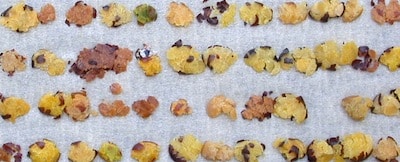
Some canola growers have reported rising temperatures in their canola bins.
Growers are encouraged to check all canola bins as soon as possible. Heating can start small and go unnoticed for days and perhaps weeks. Cooling the bin and stopping this early heating now can save a lot of money in lost grade and lost delivery options.
Reasons for the increase in heated canola are wide ranging. They include hot harvest in August, high moisture at binning, green weed seeds and green canola seeds. Cool temperatures, rainfall or humid conditions at harvest will increase risk factors. (Top 10 risky situations for canola storage)
What to do? Temperature cables are a good way to monitor whole bins. They may not always detect initial hot spots, but they will show temperature increases that suggest a whole bin is at risk. Without cables, accurate assessment requires a physical transfer of canola from one bin to another. Hand probing through doors or roof hatches is unreliable for finding hot spots near the core of the bin. When transferring, move at least one third of the canola out of a bin. If green counts, moisture, weeds or dockage are high (in short, anything that may increase the storage risk), transferring the whole bin may be safest.
Feel and smell the canola as it comes out of the bin. If canola has started to spoil, start looking for delivery options. Many of the companies on this list will buy heated canola.
Does your storage measure up? Cool conditions in the fall make it difficult to dry canola using aeration alone. Is it time for a heated air system, or a dryer? For more on storage considerations, the Canola Council of Canada has archived videos on floors, fans, bins and storage safety.
Here are two Canola Watch reader questions about how hot is too hot and safe drying temperatures.
